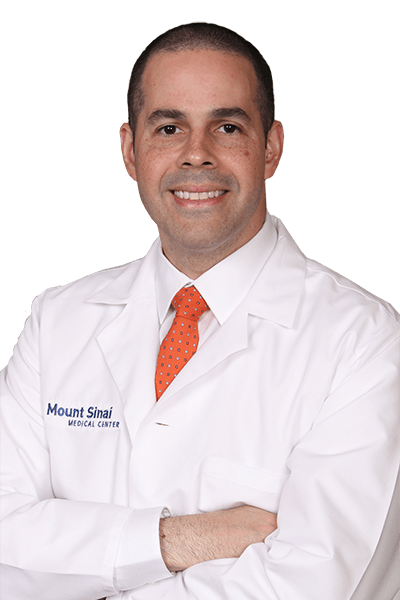Liver Conditions
At Mount Sinai Medical Center, the gastroenterology and hepatology department offers approaches for diagnosing and treating the full range of chronic and acute liver diseases in adults, including cirrhosis of the liver, which is a late stage of fibrosis (scarring).
Alpha-1 Antitrypsin Deficiency
Alpha-1 antitrypsin deficiency (AATD) is an inherited disease that results in the increased risk of having chronic obstructive pulmonary disease (COPD), liver disease, skin problems, and inflammation of the blood vessels. Adults with apha-1 antitrypsin deficiency typically have lung problems, whereas both children and adults can have liver and skin problems. The age symptoms begin and the severity of symptoms can vary depending on how much working alpha-1 antitrypsin protein (AAT) a person has. Symptoms may include shortness of breath and wheezing, repeated infections of the lungs and liver, yellow skin, feeling overly tired, rapid heartbeat when standing, vision problems, and weight loss.
Treatment
- Augmentation Therapy – This increases the blood level of alpha-1 antitrypsin protein (AAT) through intravenous (IV) infusion. The goal is to prevent the progression of lung disease. Skin problems usually get better as well. Augmentation therapy does not affect liver disease associated with AATD.
Autoimmune Hepatitis
Autoimmune hepatitis is a disease in which the body’s immune system attacks liver cells, which causes inflammation of the liver, known as hepatitis. It can lead to cirrhosis of the liver and/or liver failure. Autoimmune hepatitis likely results from a combination of autoimmunity, environmental triggers, and a genetic predisposition. It occurs more frequently in women.
Treatment Options
- Corticosteroids
- Liver Transplant
- Medications
Cirrhosis
A wide range of conditions can damage the liver and lead to cirrhosis, such as chronic alcohol abuse, chronic viral hepatitis (hepatitis B, C, and D), fat accumulating in the liver (nonalcoholic fatty liver disease), iron build-up in the body (hemochromatosis), cystic fibrosis, copper accumulated in the liver (Wilson disease), alpha-1 antitrypsin deficiency, liver disease caused by your body’s immune system (autoimmune hepatitis), destruction of the bile ducts (primary biliary cirrhosis), scarring of the bile ducts (primary sclerosing cholangitis), and medications, including methotrexate or isoniazid.
Each time your liver is injured, it leads to scar tissue formation. As cirrhosis progresses, more and more scar tissue forms, making it difficult for the liver to function (decompensated cirrhosis). Advanced cirrhosis is life-threatening. The damage done by cirrhosis generally cannot be reversed, but if cirrhosis is diagnosed early, and the cause is treated, the damage can be halted and sometimes reversed.
Some of the complications of cirrhosis include:
- Bleeding – Portal hypertension can cause blood to be redirected to smaller veins, which may cause enlarged veins (varices) in the esophagus and/or in the stomach. These smaller veins can burst, causing serious life-threatening bleeding.
- Hepatic Encephalopathy – A liver with cirrhosis can reach a point of dysfunction where it doesn’t filter toxins from the body, which is the liver’s main function. These toxins can build up in the brain and cause confusion and difficulty concentrating. With time, this can progress to coma.
- Increased Risk of Liver Cancer – Patients with cirrhosis need to get pictures of their liver every six months to look for liver cancer. If found early, it can be treated.
- Jaundice – This occurs when the sick liver can’t remove enough bilirubin from your blood. It builds up in other tissues, causing yellow discoloration of the skin and eyes.
- Lower Extremity Edema and Ascites – Ascites is the presence of fluid in the abdomen. A low-sodium diet is required, and in the majority of cases, diuretics are needed. Sometimes the fluid needs to be removed using a needle (paracentesis) or requires a special vascular procedure called TIPS (transjugular intrahepatic portosystemic shunt).
- Portal Hypertension – Cirrhosis slows the blood flow through the liver, increasing pressure in the vein that brings blood to the liver from the abdomen. This can result in fluid retention and GI bleeding.
Fatty Liver Disease
There are two types of fatty liver disease: alcoholic liver disease and nonalcoholic fatty liver. Alcoholic fatty liver is the accumulation of fat in the liver as a result of heavy alcohol drinking. Nonalcoholic fatty liver disease occurs in people who aren’t heavy drinkers, but have other conditions, such as obesity, diabetes, high cholesterol, and hypertension.
Symptoms of both include right upper quadrant pain or fullness, loss of appetite, nausea, weight loss, jaundice, tiredness, weakness, and mental confusion.
Treatment Options
- Alcohol Abstinence
- Controlling Diabetes
- Losing Weight
- Lowering Blood Pressure
- Lowering Cholesterol
Hemochromatosis
Hemochromatosis is the abnormal accumulation of iron in organs, leading to organ toxicity. It is the most common autosomal recessive genetic disorder and the cause of severe iron overload.
About 75% of patients with hereditary hemochromatosis don’t have symptoms. Or it can present with general signs and symptoms. Early symptoms include severe fatigue, impotence, and joint aches. The most common signs at the time of presentation are enlarged liver and skin pigmentation (bronzing).
Treatment Options
- Chelation – This removes iron by binding to another substance.
- Liver transplant (in case of liver failure)
- Venesection – This is draining off of blood.
Hepatitis A, B, and C
Hepatitis A virus, or HAV, is found in the feces of people with hepatitis A and is usually spread by close personal contact (including sex or living in the same household). It can also be spread by food or drinking water that is contaminated with HAV.
Hepatitis B, or HBV, is found in blood and certain body fluids. The virus is spread when blood or body fluid from an infected person enters the body of a person who is not immune. Hepatitis B is spread through having unprotected sex with an infected person, sharing needles, exposure to needle sticks or sharps on the job, or from an infected mother to her baby during birth. Exposure to infected blood in any situation is a risk for transmission.
Hepatitis C, or HCV, is found in blood and certain body fluids. The virus is spread when blood or body fluid from an HCV-infected person enters another person’s body. HCV is spread through sharing needles when injecting drugs, exposure to needle sticks or sharps on the job, or sometimes from an infected mother to her baby during birth. It is possible to transmit hepatitis C during sex, although it is uncommon.
The symptoms of hepatitis A, B, and C are similar. They include fever, fatigue, right upper quadrant pain, joint aches, nausea, and vomiting, diarrhea, loss of appetite, jaundice, dark urine, and pale-colored stools.
Treatment Options
There is no treatment for hepatitis A other than supportive care. Patients should avoid alcohol, as it can worsen liver disease.
People with chronic hepatitis B infection should have regular medical monitoring for signs of liver disease or liver cancer. Several antiviral medications are available to treat individuals with chronic hepatitis B virus infection. Liver transplant is the last resort, but livers are not always available. Patients should avoid alcohol, as it can worsen liver disease. There is no medication to treat recently acquired hepatitis B infection.
There are drugs available for the treatment of chronic hepatitis C infection, and more than 90% of infected people can clear infection with 8 to 12 weeks of oral therapy. Patients should avoid alcohol, which can worsen liver disease.
Hepatocellular Carcinoma (Liver Cancer)
Hepatocellular carcinoma (HCC) is a primary liver cancer that occurs predominantly in patients with underlying chronic liver disease and cirrhosis. However, up to 25% of patients with HCC have no history of cirrhosis or risk factors for it. Hepatitis B and hepatitis C strongly increase the risk of developing chronic liver disease and subsequent development of hepatocellular carcinoma.
Nonalcoholic steatohepatitis (NASH) also increases the risk of HCC. NASH develops more commonly in people with obesity, type 2 diabetes, dyslipidemia, and hypertension. Symptoms include itching, jaundice, enlarged spleen, bleeding vessels around the esophagus, muscle wasting, increased abdominal girth from fluid collection inside the abdomen (ascites), and right upper quadrant pain.
Treatment Options
- Radiofrequency Ablation (RFA)
- Minimally invasive liver surgery
- Systemic Therapy – Our team uses medications such as sorafenib (or, if sorafenib fails, regorafenib, nivolumab, lenvatinib, pembrolizumab, cabozantinib, or ramucirumab).
- Liver Transplantation
Primary Biliary Cholangitis (PBC)
Primary biliary cholangitis (PBC), formerly known as primary biliary cirrhosis, is a chronic disease of the liver. This autoimmune disease leads to slowing of the bile passage (cholestasis) and often end-stage liver disease. Symptoms include itching, jaundice, fatigue, and right upper quadrant pain. Genetics and a history of urinary tract infections may play a role. The disease results in the destruction of small and medium bile ducts, which impairs bile flow and builds toxins.
Treatment Options
- Antihistamines – Itching can be treated with antihistamines, which are the first choice drugs for patients with mild-to-moderate itching.
- Medication – Drugs include cholestyramine and colestipol, rifampin, dronabinol (Marinol), and plasmapheresis.
- Obeticholic Acid – This may be considered in combination with other medication.
Primary Sclerosing Cholangitis (PSC)
PSC is caused by blocked bile ducts due to inflammation and scarring, which eventually damages the liver and can lead to cirrhosis and liver failure. This will require a liver transplant in most cases after 10-15 years. Approximately 70% of patients with PSC have either ulcerative colitis or Crohn’s. Symptoms may include fatigue, jaundice, right upper quadrant pain, itching, fever, chills, and weight loss.
Treatment Options
- Chelators
- Immunosuppressants – These reduce immune system activity in the body.
- Liver Transplant (in case of liver failure)
- Steroids
Wilson Disease
Wilson disease is a rare, inherited disorder of copper metabolism. It causes excessive deposits of copper in the liver, brain, and other tissues. Wilson disease is often fatal if not recognized and treated when symptoms arise. These symptoms can include difficulty speaking, walking funny, excessive salivation, clumsiness with hands, personality changes, spastic movements, seizures, and impulsive behavior. It can lead to liver failure.
Treatment Options
- Medications
- Zinc Salts
Our Physicians
Kfir Ben-David, MD
Roni Jacobson Chairman, Department of Surgery
Program Director, General Surgery Residency
- Cancer
- General Surgery
- Surgical Oncology
- Robotic Surgery
- Bariatric
- Gastroenterology
- Mount Sinai Medical Center (Main Campus)
- 305.674.2397
- Mount Sinai Medical Center (Main Campus)
- 305.674.2240
Frank Czul-Gurdian, MD
- Gastroenterology
- Mount Sinai Medical Center (Main Campus)
- (305) 674-2240
- Mount Sinai Primary & Specialty Care Miami Shores
- (305) 891-3710
Manuel O Gonzalez, MD
- Gastroenterology
- Mount Sinai Medical Center, Kenneth C. Griffin Center, Hialeah – Emergency Center and Primary & Specialty Care | Mount Sinai Eldercare
- 786.584.5555





